Why More Farmers Are Turning To AI Machines
Authored by Autumn Spredemann via The Epoch Times,
Artificial intelligence-powered harvesters, drones, and precision farming systems are quickly entering the mainstream of American agriculture. At its core, the technology promises efficiency and sustainability and carries a potential solution to a decades-old farming problem: the need for physical labor.
As the capabilities of robotics evolve, many jobs that once required human hands are being delegated to machines. Some artificial intelligence (AI) developers working on integrating this technology into America’s farms say early data support the possibility of a major farm labor force reduction.
The American Farm Bureau Federation estimated 17 percent of all U.S. agricultural labor in fiscal year 2024 comprised temporary migrant workers brought in under the H-2A visa program.
There are also millions of illegal immigrant workers, who, according to the United States Department of Agriculture (USDA) made up 42 percent of farm workers from 2020 to 2022.
Roman Rylko, chief technology officer of Pynest, said his company has worked with vegetable growers in the Midwest to deploy AI systems.
“We built the onboard model that lets an autonomous weeder separate spinach seedlings from pigweed in real time. A single rig now clears a 50-acre block in about eight hours. Before, that job meant a crew of 10 walking the rows for two days,” he told The Epoch Times.
Rylko’s firm works with growers to implement machine-learning models into field-deployable robotics.
“Autonomous tractors won’t kill field labor; they’ll move it up the stack, from stoop work to sensor maintenance and fleet orchestration,” he said.
“Our growers cut seasonal hand-weeding hours by roughly 70 percent, yet hired two techs to keep cameras clean, retrain the model on new cultivars and swap battery packs.”
Migrant farmworkers harvest lettuce in Brawley, Calif., on Dec. 10, 2024. U.S. agriculture has long relied on migrant labor, but advances in robotics and AI could significantly reduce the farm workforce. Sandy Huffaker/AFP via Getty Images
Rylko cited data from a recent AI-powered machine trial.
“Our last trial logged 1.6 million weeds pulled per day—equivalent to 12 workers—at 32 percent lower total cost per acre,” Rylko said.
“The grower’s biggest surprise wasn’t speed, it was consistency. Robots don’t call in sick during peak weed flush.”
Among the producers paving the way for AI in the fields is Wish Farms, a Florida-based berry grower that has been experimenting with robotic harvesters in response to persistent labor shortages.
Wish Farms grows strawberries, one of the most labor-intensive commercial row crops. In collaboration with Harvest CROO Robotics, Wish Farms has test-piloted an all-in-one crop solution with an AI-powered machine.
Joe McGee, the CEO of Harvest CROO Robotics, told The Epoch Times that strawberries are an ideal place for AI to step into the farm labor scene.
“Strawberries need to be picked every three days. It’s one of the most dense labor crops you could pick,” he said.
This is where automated crop management can offer what McGee called a “pick to pack” solution.
“The company completed its first commercial runs of fully autonomous strawberry harvesting earlier this year and in the 2024–2025 Florida season,” McGee said.
“Our harvester, robotics system, and AI have been autonomously harvesting strawberries in production fields, and we’ve shipped revenue-generating berries.”
Roughly the size of a shipping container, the AI-powered, camera-guided machine McGee described crawls between rows of berries, its robotic arms rapidly identifying and yanking the delicate produce for weighing and packing. Normally, this work could take a stooped labor force days to complete, depending on the weather, heat index, and amount of daylight hours available.
It takes about 16 hours for the AI harvester to complete the same work. The machine can perform the equivalent work of 25 human laborers, according to McGee.
An attendee watches the smart farming Doosan Robotics M1013 (L) robot demonstrate its capabilities at CES 2022 at the Las Vegas Convention Center on Jan. 6, 2022. The M1013 can measure the sweetness of fruit and harvest them without bruising. It can also be used for seeding, watering, planting, and pesticide spraying. Ethan Miller/Getty Images
The AI-powered harvester also does more than just pick strawberries. It performs the complete sequence of tasks from transitioning between rows to scanning, identifying, and picking ripe berries. They are then sanitized and chilled to prepare for immediate packaging.
This is a more critical part of the process than most realize. If a strawberry is picked, weighed, and packaged, but not up to grade for retail selling, it will get rejected. This can cost a producer a lot of money. Three percent of a crop can be lost in packaging alone, while retail distribution accounts for another 18 percent of produce losses, according to the USDA.
“Food may be left unharvested in a field or not sold by a distributor for a variety of economic reasons, including price volatility, labor cost, lack of refrigeration infrastructure, consumer preferences, quality-based contracts, and various policies related to produce,” the USDA stated.
According to McGee, seasonal workers have monetary incentives to harvest the largest possible volume, so their judgment on quality isn’t always aligned with retail sale requirements. This is where AI-harvesters can step in and make a no-stakes decision based on programming.
McGee said after the initial cosmetic analysis, the strawberries go to the upper deck of the AI harvester, where it has to pass the weight test. If the product is underweight by retail standards, it won’t be packaged.
“The error rate of human pickers is around 10 percent, but with AI, we can get that down to zero,” McGee said.
Rylko and McGee aren’t the only ones who see a promising partnership between AI and agriculture. University studies and field tests are being conducted with AI robotics in North Carolina, Georgia, and Iowa for yield monitoring, weeding, pest control, and harvesting. All of these jobs currently require a substantial amount of manual labor.
A solar-powered Aigen Element autonomous AI robot demonstrates how it hammers down on targets at Bowles Farm in Los Banos, Calif., on June 26, 2025. The robot eliminates herbicide-resistant weeds with precise ground strikes, reducing chemical use and saving labor. Josh Edelson/AFP via Getty Images
“We’re living in very exciting times for AI and agriculture,” said Baskar Ganapathysubramanian, director of the AI Institute for Resilient Agriculture at Iowa State University.
“We’re going to see significant progress in the next decade.”
Meanwhile, heavy equipment manufacturers such as John Deere have also entered the AI farming race with fully autonomous tractors that can plow and plant without a driver in the cab.
Beyond picking and packing, a 2023 study published in AI & Society supports the position that AI may be able to resolve the long-standing issue of farm labor shortages. Last year, there were an estimated 2.4 million agricultural job openings in the United States, and 56 percent of farmers reported worker shortages.
Changing Seasons
For decades, the U.S. agricultural sector has depended heavily on migrant workers, particularly acquired through the H-2A visa program, which allows foreign workers to take temporary agricultural jobs. As more farms turn to AI for solutions, the long-term role of these seasonal workers is uncertain.
In a Baker Institute for Public Policy report, researchers found that foreign workers—legal and illegal—play a “disproportionate role in ensuring a reliable supply of food for American households.”
A recent Kaiser Family Foundation analysis found that 47 percent of all U.S. agricultural workers are illegal immigrants without proper work authorization, while 18 percent are noncitizens, with legal working status.
Around 400,000 certified H-2A workers arrive in the United States annually, according to the USDA.
Migrant farmworkers harvest spinach near Coachella, Calif., on Feb. 24, 2017. H-2A visa workers constituted about 17 percent of U.S. farm labor in fiscal 2024, according to American Farm Bureau Federation estimates. David McNew/AFP via Getty Images
But McGee has seen how even legal workers can be expensive, complicated, and unreliable for producers.
A farmer pays thousands of dollars to bring the seasonal workers in, transport and house them, then McGee said many simply “abscond” before or near the end of their work contract.
“So the issue is getting the people, the cost of the people, and the reliability of having them for the whole season,” he said.
Rylko said his company’s early testing supports the idea of a reduced need for human labor.
“Relative gains and the shift in labor profile are representative of what we’re seeing across several [AI-machine] deployments,” he said.
Nonetheless, it will take time and a lot of investment to meet the existing demand from American farms. Machine labor or otherwise.
Like all new technologies, AI-driven farm equipment comes with hefty upfront costs into the tens of thousands. This could deter smaller agricultural producers. Base prices for autonomous tractors are around $500,000, without including maintenance and electricity needs.
McGee said his company validated their AI-powered harvester this year, but is currently facing funding hurdles to reach the next stage because this emerging technology is still an “unstructured market.”
“Right now, we have one harvester, but the demand [from other farms] is 1,500. We have a grower in Florida that placed an order for 165 machines,” he said.
Investment in the AI-agriculture market was valued at just under $2 billion in 2023, according to Grand View Research, and it is expected to surge at a compound annual growth rate of more than 25 percent per year through 2030.
Tyler Durden
Mon, 08/25/2025 – 20:55ZeroHedge NewsRead More


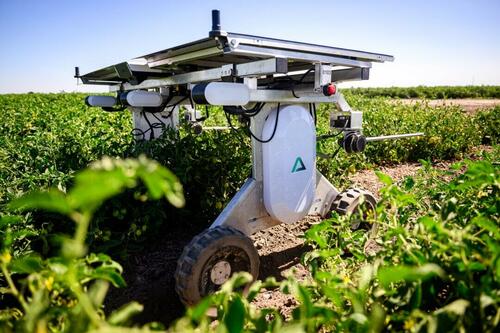
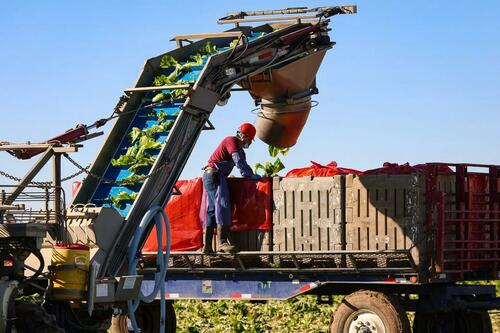
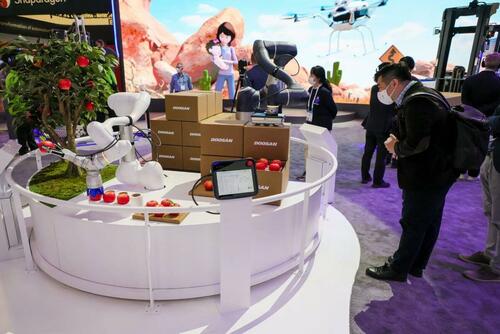
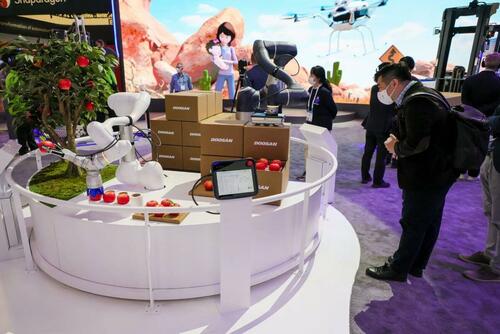
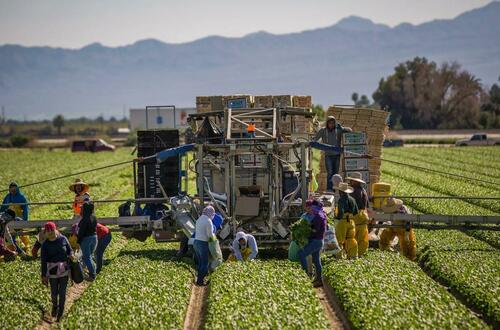



 T1
T1


